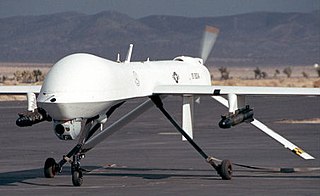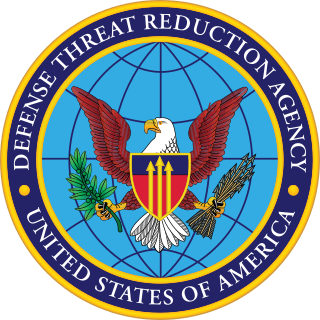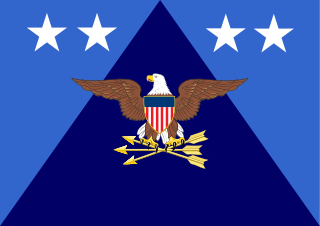Related Research Articles

The Defense Advanced Research Projects Agency (DARPA) is a research and development agency of the United States Department of Defense responsible for the development of emerging technologies for use by the military.
An autonomous robot is a robot that acts without recourse to human control. Historic examples include space probes. Modern examples include self-driving vacuums and cars.

Non-lethal weapons, also called nonlethal weapons, less-lethal weapons, less-than-lethal weapons, non-deadly weapons, compliance weapons, or pain-inducing weapons are weapons intended to be less likely to kill a living target than conventional weapons such as knives and firearms with live ammunition. It is often understood that unintended or incidental casualties are risked wherever force is applied, however non-lethal weapons minimise the risk of casualties as much as possible. Non-lethal weapons are used in policing and combat situations to limit the escalation of conflict where employment of lethal force is prohibited or undesirable, where rules of engagement require minimum casualties, or where policy restricts the use of conventional force. However, these weapons occasionally cause serious injuries or death due to allergic reactions, improper use and/or other factors; for this reason the term "less-lethal" has been preferred by some organizations as it describes the risks of death more accurately than the term "non-lethal", which some have argued is a misnomer.

Military robots are autonomous robots or remote-controlled mobile robots designed for military applications, from transport to search & rescue and attack.

An unmanned combat aerial vehicle (UCAV), also known as a combat drone, fighter drone or battlefield UAV, is an unmanned aerial vehicle (UAV) that is used for intelligence, surveillance, target acquisition, and reconnaissance and carries aircraft ordnance such as missiles, anti-tank guided missiles (ATGMs), and/or bombs in hardpoints for drone strikes. These drones are usually under real-time human control, with varying levels of autonomy. UCAVs are used for reconnaissance, attacking targets and returning to base; unlike kamikaze drones which are only made to explode on impact, or surveillance drones which are only for gathering intelligence.

The Defense Threat Reduction Agency (DTRA) is both a defense agency and a combat support agency within the United States Department of Defense (DoD) for countering weapons of mass destruction and supporting the nuclear enterprise. Its stated mission is to provide "cross-cutting solutions to enable the Department of Defense, the United States Government, and international partners to Deter strategic attack against the United States and its allies; Prevent, reduce, and counter WMD and emerging threats; and Prevail against WMD-armed adversaries in crisis and conflict." DTRA is headquartered in Fort Belvoir, Virginia. The DTRA mission, organization and management, responsibilities and functions, relationships, authorities, and administration are defined in DoD Directive 5105.62, Defense Threat Reduction Agency (DTRA) .
Network-centric warfare, also called network-centric operations or net-centric warfare, is a military doctrine or theory of war that aims to translate an information advantage, enabled partly by information technology, into a competitive advantage through the computer networking of dispersed forces. It was pioneered by the United States Department of Defense in the 1990s.
The United States government classification system is established under Executive Order 13526, the latest in a long series of executive orders on the topic of classified information beginning in 1951. Issued by President Barack Obama in 2009, Executive Order 13526 replaced earlier executive orders on the topic and modified the regulations codified to 32 C.F.R. 2001. It lays out the system of classification, declassification, and handling of national security information generated by the U.S. government and its employees and contractors, as well as information received from other governments.
Autonomic networking follows the concept of Autonomic Computing, an initiative started by IBM in 2001. Its ultimate aim is to create self-managing networks to overcome the rapidly growing complexity of the Internet and other networks and to enable their further growth, far beyond the size of today.

The under secretary of defense for personnel and readiness, or USD (P&R) is a high-ranking civilian position in the Office of the Secretary of Defense (OSD) within the United States Department of Defense responsible for advising the secretary and deputy secretary of defense on recruitment, career development, pay and benefits, and oversight of the state of military readiness. The under secretary is appointed from civilian life by the president and confirmed by the Senate to serve at the pleasure of the President.
Swarming is a battlefield tactic designed to maximize target saturation, and thereby overwhelm or saturate the defences of the principal target or objective. Defenders can overcome attempts at swarming by launching counter-swarming measures that are designed to neutralize or otherwise repel such attacks.
The SGR-A1 is a type of autonomous sentry gun that was jointly developed by Samsung Techwin and Korea University to assist South Korean troops in the Korean Demilitarized Zone. It is widely considered as the first unit of its kind to have an integrated system that includes surveillance, tracking, firing, and voice recognition. While units of the SGR-A1 have been reportedly deployed, their number is unknown due to the project being "highly classified".

Targeted killing is a form of assassination carried out by governments outside a judicial procedure or a battlefield.

Lethal autonomous weapons (LAWs) are a type of autonomous military system that can independently search for and engage targets based on programmed constraints and descriptions. LAWs are also known as lethal autonomous weapon systems (LAWS), autonomous weapon systems (AWS), robotic weapons or killer robots. LAWs may operate in the air, on land, on water, underwater, or in space. The autonomy of current systems as of 2018 was restricted in the sense that a human gives the final command to attack—though there are exceptions with certain "defensive" systems.
The term kill chain is a military concept which identifies the structure of an attack. It consists of:
An autonomous aircraft is an aircraft which flies under the control of automatic systems and needs no intervention from a human pilot. Most autonomous aircraft are unmanned aerial vehicle or drones. However, autonomous control systems are reaching a point where several air taxis and associated regulatory regimes are being developed.

A loitering munition, also known as a suicide drone, kamikaze drone, or exploding drone, is a kind of aerial weapon with a built-in warhead that is typically designed to loiter around a target area until a target is located, then attack the target by crashing into it. Loitering munitions enable faster reaction times against hidden targets that emerge for short periods without placing high-value platforms near the target area and also allow more selective targeting as the attack can be changed mid-flight or aborted.
A military artificial intelligence arms race is an arms race between two or more states to develop and deploy lethal autonomous weapons systems (LAWS). Since the mid-2010s, many analysts have noted the emergence of such an arms race between global superpowers for better military AI, driven by increasing geopolitical and military tensions.

The space policy of the Donald Trump administration, as of December 2020, comprises six Space Policy Directives and an announced "National Space Strategy", representing a directional shift from the policy priorities and goals of his predecessor, Barack Obama. A National Space Policy was issued on December 9, 2020.
The Political Declaration on Responsible Military Use of Artificial Intelligence and Autonomy is an international norms and arms control proposal by the U.S. government for artificial intelligence in the military.
References
- ↑ https://www.csis.org/analysis/state-dod-ai-and-autonomy-policy
- ↑ US Department of Defense (2012). "Directive 3000.09, Autonomy in weapon systems" (PDF). p. 2. Archived from the original (PDF) on December 1, 2012.
- 1 2 Gubrud, Mark (April 2015). "Semi-autonomous and on their own: Killer robots in Plato's Cave". Bulletin of the Atomic Scientists. Archived from the original on 2017-05-09. Retrieved 2017-10-30.